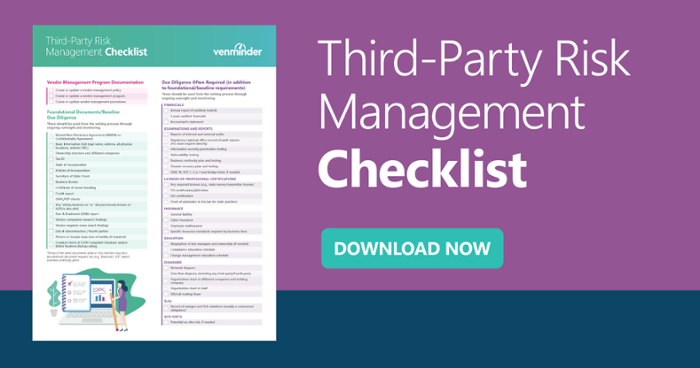Can you believe it? 2019, a year for the books, is almost over. This year, there have been a lot of regulatory changes, updates, shifting priorities and more. So, in light of all this, what are the third party risk management best practices to take with you into 2020?
20 Third Party Risk Management Best Practices for 2020
These are the 20 that I recommend, in countdown style:
20. Keep your vendor lists updated. If it’s been six months or more since you went to accounts payable and asked for a new list, you’re overdue.
19. Study enforcement actions. The CFPB has promised to define the Abusive standard in Unfair, Deceptive, or Abusive Acts or Practices (UDAAP), but it’s a long way from happening, so until it does, study enforcement actions closely.
18. Remember to assign individual accountability where needed. Who owns a process, and do they understand they truly own it?
17. Never provide “off the cuff” or unprepared remarks to examiners. Be prepared.
16. Remember that haphazard, as opposed to prepared and professional, leads to loose threads to be pulled. And, things unravel.
15. “Fake it till you make it” won’t get you very far in third party risk management. It only works on Broadway.
14. Make ongoing monitoring a priority. It’s an area of incredible focus.
13. Take every single data breach seriously. Whether it’s a single source provider or a provider your entire industry uses, your customers are your responsibility.
12. Stay compliant. Regulatory reform is great in concept but remember that compliance with the current regulations and laws is mandatory.
11. Keep your policy and program documents updated. And, make sure they’re board approved.
10. Review your critical third parties’ business continuity plans. Don’t only review them, but also test annually.
9. Document everything. Documentation is a key to success in third party risk management. If it isn’t documented, it didn’t happen.
8. Work with your CFO or budgeting team to obtain the resources you need. Staffing and adequate budget remain a concern.
7. Track your investment in education. Demonstrate that it’s an ongoing priority, not just at exam time, but throughout the year.
6. Keep your board and senior management team adequately informed. Be able to demonstrate it through minutes and reporting.
5. Be sure third party risk management is a part of your annual audit cycle and is also reflected in the other programs it may help support (e.g., OFAC, BSA/AML, credit verification).
4. Make sure all of the pillars of third party risk management are adequately covered and actively managed. The pillars are selecting a vendor, risk assessment, due diligence, ongoing monitoring, contractual standards and reporting.
3. Third party risk management shouldn’t be a one and done exercise. It must be a focus throughout the life of the vendor relationship.
2. Ensure your senior management team is giving you the support you need. This goes vice versa, too.
1. Make cybersecurity a priority. It’s the hottest topic out there.
There you have it. Based on what has happened over the last year in the industry, I’d recommend you take these top 20 best practices and ensure they’re implemented into your organization’s third party risk management program.
Make sure that you also consider each of the items on this third party risk checklist. Download it now.



















